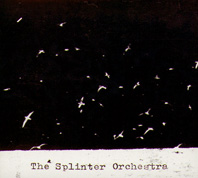 |
Split Records splitrecCD 17
http://www.splitrec.com/
Sydney-based ensemble The Splinter Orchestra has made a name for itself in recent years for live improvisations, particularly at events such Liquid Architecture and through the landmark ABC TV series Set (2006). This is the debut, self-titled CD and is significant both in bringing recordings of the ensemble’s work to the public and in reframing its oeuvre through the process of recording.
The CD contains five tracks in all. The first, simply entitled First Play, opens quietly with a long, barely audible drone at very low frequency, the other instruments progressively entering. The performers play quietly and the sound gradually builds as each instrument’s distinct voice emerges. This is complex music demanding careful attention. The second and fifth tracks are entitled First Tutti and Second Tutti respectively, indicating that the whole ensemble is joining in, whereas other tracks are free improvisation, where individual performers might or might not contribute, depending on what develops.
First Tutti opens frenetically. Each performer seems to work through tightly prescribed idioms resulting in an impenetrably dense layering, but within a more restricted dynamic range than that of the first track. Less lyrical and more monotonal, the combinations of sounds produce interesting hybrid textures. There is a long trombone drone in the background, which morphs into a hypnotically rhythmic whirring sound as the piece quietens towards its conclusion. Though developed from a composite of disparate noises, the piece gains a level of coherence that suggests an intimately shared sensibility.
Track 3, Second Play, opens quietly with teasing arpeggios at the top end of what sounds like a prepared piano. Other sounds are progressively layered over it and a restrained, minimalist lyricism emerges. Again the piece quietens towards the end, some electronics closing it out. Third Play commences almost imperceptibly and gradually gains momentum. Overall, the music is dense but elegant and restrained, slowly seducing rather than forcing itself on you.
The interest in such music lies in the extraordinary lyrical complexity that emerges from the combinations of instruments, even if they are playing simple, repeated motifs. It also lies in the almost infinite variety of timbres and textures that are generated from the instruments as they combine. Musical development occurs through the blending of instrumental voices and the players’ responses to the overall effect, rather than through programmed structures or melodic line. In the pieces for free improvisation the performers respond to each other to build the most engaging compositions. Each time you listen to this CD, you hear new things and follow new trails. It’s like getting to know a forest intimately though, in a sense, this is a petrified forest, and those unexpected moments and unpredictable interactions that characterise improvisation are frozen into this disc.
The CD notes indicate the kinds of instructions given to the performers for their performances. For example, for the tuttis, the ensemble might be divided into three sub-sections and there might be signals to each sub-section to start or stop playing, within which each member is to make only one sound and to play at will. The final recording was edited and mixed from many hours of studio performance and the five pieces coalesce into a work that is symphonic in scale if not in form. Though editing and mixing challenge the concept of live improvisation, the result retains its freshness and dynamism.
There are 27 performers listed in the CD’s credits, playing a variety of wind and brass instruments, several basses, accordion, percussion, guzheng, organ, synthesiser and laptop, often at the limits of technique. Though there have been frequent changes of membership, most members have worked together extensively, and they achieve a unique and profound musicianship. Evidently, the final recording was the product of long rehearsals and careful planning, so that the improvisation is mediated by the members’ experience in ensemble as well as by the instructions to the performers. That such large-scale improvisation can work at all is remarkable, and it works marvellously. The CD’s total running time of 44 minutes seems underweight, but more might have resulted in less, given how carefully measured each element seems to be and how well it comes together as an opus. This is an enchanting disc, and a most important development both for The Splinter Orchestra and for music generally.
Chris Reid
© Chris Reid; for permission to reproduce apply to [email protected]








 back
back